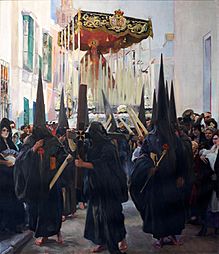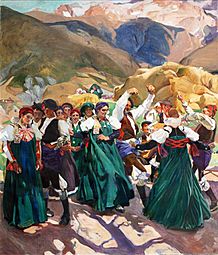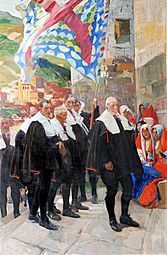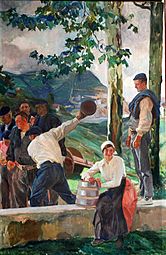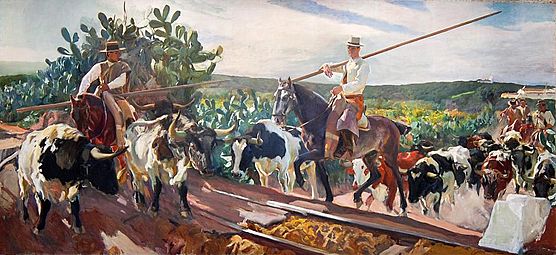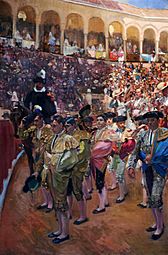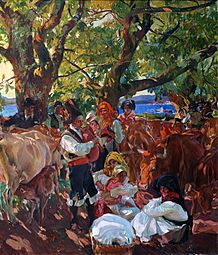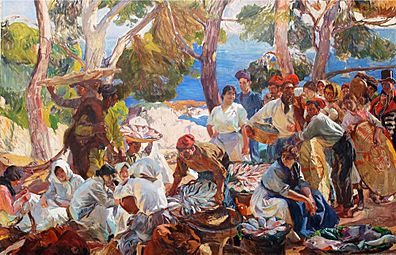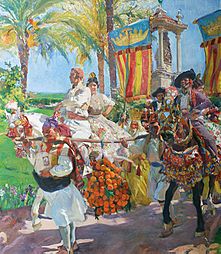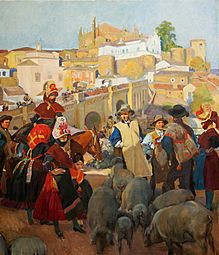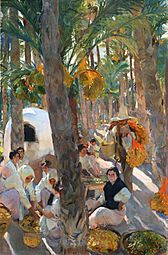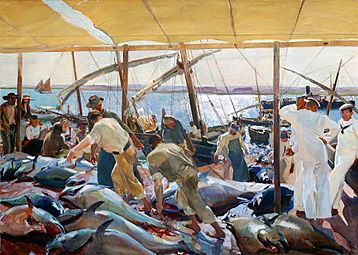Vision of Spain facts for kids
Quick facts for kids Vision of Spain |
|
|---|---|
| The Provinces of Spain | |
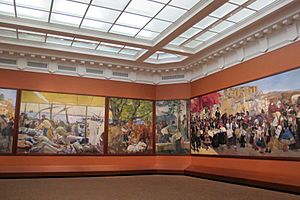 |
|
| Artist | Joaquín Sorolla |
| Year | 1913–19 |
| Medium | Oil on canvas |
| Location | Hispanic Society of America, New York City |
Vision of Spain (also called The Provinces of Spain) is a huge series of fourteen paintings by the Spanish artist Joaquín Sorolla. He created these amazing artworks between 1913 and 1919. The paintings show the different customs, clothes, and traditions from various parts of Spain. A man named Archie Huntington asked Sorolla to paint them for the Hispanic Society of America (HSA) museum.
Contents
Creating a Masterpiece
In 1911, Sorolla met Archie Huntington in Paris. They signed a deal for Sorolla to paint a series of large oil paintings about life in Spain. These fourteen amazing murals are very tall, about 12 to 14 feet (3.7 to 4.3 meters) high. Together, they stretch for 227 feet (69 meters)! This was the biggest job of Sorolla's life, and it took up many of his later years.
Huntington first wanted the paintings to show the history of Spain. But Sorolla preferred to show a "Vision of Spain." He decided to paint the different regions of Spain, calling the series The Provinces of Spain. Even though the canvases were huge, Sorolla painted almost all of them outdoors. This is called en plein air painting. He traveled to specific places in Spain to paint them. These places included Navarre, Aragon, Catalonia, Valencia, Elche, Seville, Andalusia, Extremadura, Galicia, Guipuzcoa, Castile, Leon, and Ayamonte.
In each place, he painted models wearing local clothes. Each painting celebrated the land and culture of that region. They showed many workers and local people. By 1917, Sorolla said he was very tired. He finished the last painting in July 1919.
The Sorolla Room, where the Provinces of Spain paintings are kept, opened to the public in 1926. This room is at the Hispanic Society of America in New York City. The room closed for updates in 2008. For the first time, the murals then traveled to museums in Spain. The Sorolla Room opened again in 2010. The paintings are now back on permanent display there.
Where Else Have They Been Seen?
Even before the original paintings toured Spain, some related exhibitions took place. From late 1998 to early 1999, the Thyssen-Bornemisza Museum in Madrid and the Museum of Fine Arts in Valencia showed "Sorolla and the Hispanic Society." This exhibition featured sketches and early studies Sorolla made for the paintings. It also showed portraits of important Spanish people he painted for the Hispanic Society.
From December 2011 to March 2012, the Queen Sofía Spanish Institute in New York hosted "Joaquín Sorolla & The Glory of Spanish Dress." A famous fashion designer, Oscar de la Renta, helped create this show. It displayed original clothes, jewelry, sketches, and photos from the Sorolla Museum. The artist had used or collected these items while working on his paintings.
From December 2013 to May 2014, the Sorolla Museum and other museums in Alicante and Castellón showed "Fiesta y color. La mirada etnográfica de Sorolla" (Festivity and Color. The ethnographical view of Sorolla). This show included documentary photos and studies. It also featured several costumes and jewelry collected by Sorolla, like those seen in his painting Castilla. La fiesta del pan.
Bringing the Paintings to Life with Dance
On June 12, 2013, the Spanish National Dance Company performed a new dance show called Sorolla. This show was based on the clothes, customs, and dances from the Vision of Spain paintings. It had 250 special costumes made just for it. This dance show was also performed at the Teatre del Liceu in Barcelona in 2015. It was performed again at the Teatro Real in Madrid in November 2017.
See All the Paintings!
See also
 In Spanish: Visión de España para niños
In Spanish: Visión de España para niños



